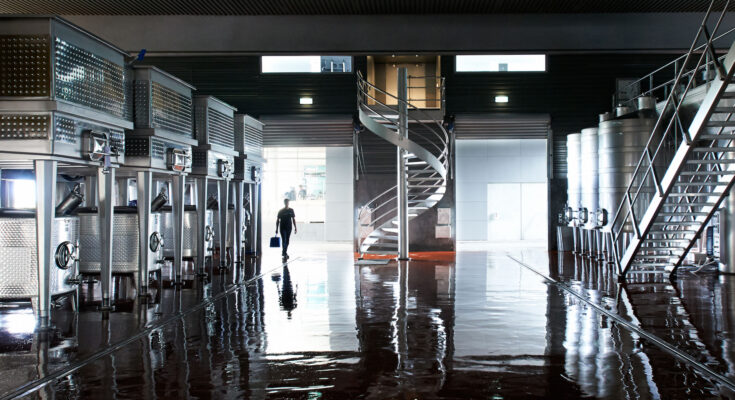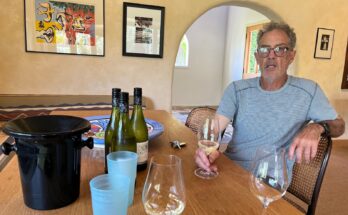One of the labels that has been on my radar for a while now – not just because friends will often say to me “David, have you tried this Elephant Hill wine, it’s amazing” or regale me with tales of idyllic lunchtime sessions down at the restaurant – but because they have a range of wines that climb through tiers to reach icon wines and seem to have something for everyone, but presented in a new way? I’ve been fascinated by the idea of the coastal vineyards along at Te Awanga and what part the location will play in the wines from that sub-region. So I’m thrilled when Marketing man Simon Swa can fit me in for a late afternoon visit and chat with winemaker Steve Skinner (a person that I hear on the grapevine is an elusive interviewee). We stick to two varietals – Chardonnay and Syrah.
Simon Swa: We just recently launched a vineyard series – a limited edition range which tells the story of each of the three sites, but we really want to tell you about our philosophies – winemaking, stylistically and approach to vineyards to give you an idea of what Elephant Hill is about.
Steve Skinner: Chardonnay has made a comeback from where it was a few years ago which is good to see. Chardonnay for us is predominantly this site. It’s particularly good for whites because of the cooling breezes. We do have a little bit of Syrah planted right at the back on clay, where it’s a bit more sheltered from the breeze, but it does work best for whites. And we’ve got quite a lot of new plantings coming along at Bridge Pa. We’ve planted Chardonnay out there – slightly warmer, a richer style coming through. And we don’t have any Chardonnay on the Gimblett. I don’t really like growing whites on very stony soils, particularly. I don’t think you get enough palate weight and richness coming through for what we like.
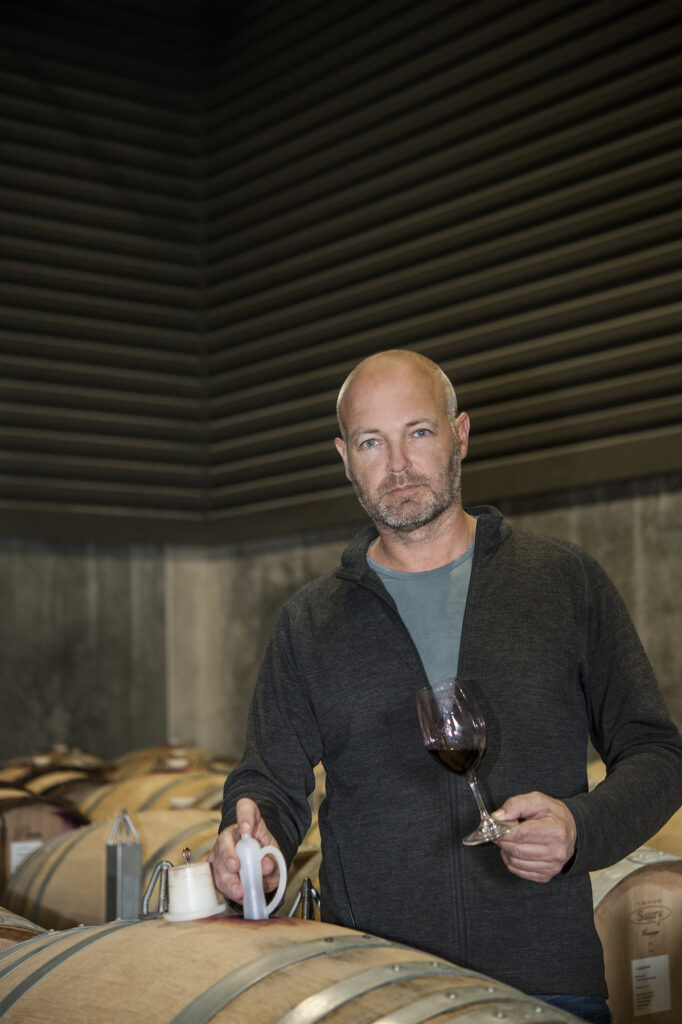
WineFolio: When was the vineyard planted here?
Steve: in 2003, all of it except the viognier which was 2004. 16-17 years old. Reasonably mature vines now. We’ve got Clone 15 which is probably my preferred Chardonnay clone for this site. We tend to retain quite a lot of acid. You get nice sugar ripeness but you don’t lose the acidity, whereas the other clone we’ve got which is Clone 95, and tends to the opposite. It loses its acid quite rapidly on this site, so we often pick it earlier and don’t get to quite capture the full expression of the site. Clone 15 is quite a citrus dominant variety, and Clone 95 is more into those white fleshed fruits like nectarines and peaches. They can be quite complimentary. And our new plantings at Bridge Pa we have three quite new clones to New Zealand, and they’re all Entav clones from Burgundy, and still young enough that we don’t quite know what we’re dealing with yet. We’re looking forward to getting some stability with those over the next two or three years.
Here at Te Awanga we get slower ripening which I like. The ideal vintage for me is long, dry and not overly hot. And that way you’ll be able to take lot of little selective picks at various points. If a vintage is too warm it tends to race through maturity quite quickly. Chardonnay from 2019 is pretty smart in Hawke’s Bay.
WF: Yes, we were all looking forward to it. I tend to talk from a consumer point of view, and there was an excitement when it was declared to be “a great year”. Cleared space in our cellars… but then they’ve come along and they seem, on the whole, to be a bit shy?
Steve: A lot of the better 2019s have just been bottled – we bottled our top chardonnays six weeks ago, and won’t be released until next year.
WF: The Beachhead that’s just won everything. I wasn’t sure that was a multi-award winner when it first came out. It’s winning me over now though.
Simon: The acidity gives it a freshness and they’re not necessarily all together yet – they’re very young wines. I don’t know whether the acid is just because it was cooler year.
Steve: 2018 was a warmer year, and with whites they can often lose that acid while you’re waiting for the flavour profile. Most winemakers have given up on adding things these days. Vintage variation is the story of cool climate winemaking.
Simon: We have four tiers. The first tier is Elephant Hill Chardonnay – I guess we’d call it our Estate. Then we have Reserve, and then the third level up is what we call our ‘Element’ Limited Edition series. And that is this story of the vineyard. I’ve got a Chardonnay from this vineyard, and the wines from here are called ‘Sea’. And the Gimblett Gravels vineyard is called ‘Stone’ and from Bridge Pa is ‘Earth’.
And a lot of the fruit from there end up in the ‘Icon’ series which is a very top series – ‘Salome’ and ‘Airavata’.
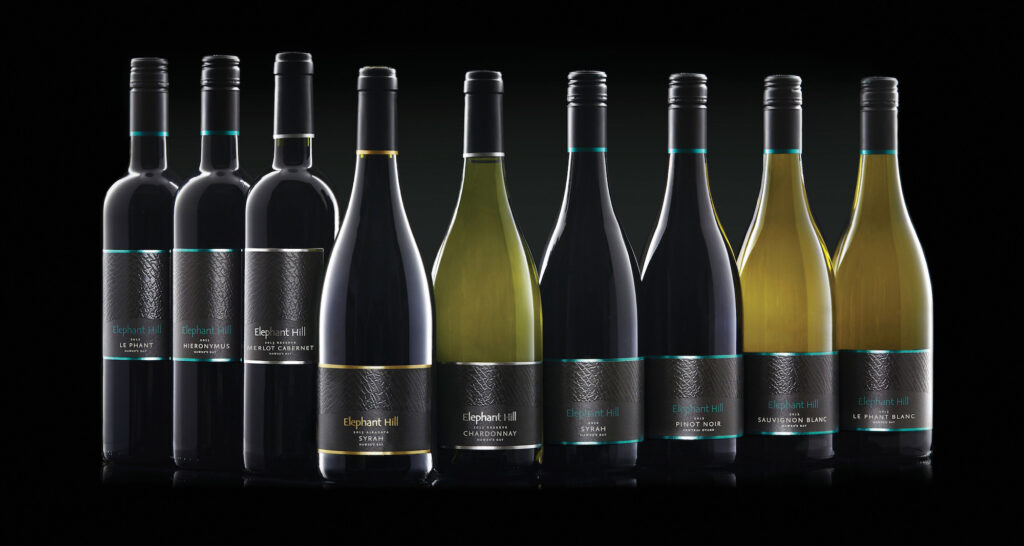
Steve: We’re top down. The Estate Chardonnay ends up being all the chardonnay that we’ve cropped for, or anything that we’ve dropped in tier from the better projects we’ve got going on. Inevitably it ends up being a Te Awanga dominant Chardonnay. It will capture some of the Bridge Pa – in 2018 it had quite a lot of the fruit from there, so it’s probably a slightly riper style than normal. In ’18 it ends up as a richer Chardonnay – but that’s also vintage variation speaking. It’s the style of wine that ’18 gives you.
As you go up we’re often selecting for more refinement and elegance, and try to encourage a bit more acidity. So by the time you get to the ‘Sea’ which is only from this site and it’s all Clone 15. It’s all vineyard-managed to make this wine, and you’ll start to see a slightly different style of chardonnay peeking through.
All the chardonnays sit around the 25-35% new oak. We’re not overly heavy-handed with oak. Whole-bunch pressed, natural yeasts from the vineyard and winery. The Estate gets about twelve months on lees and is usually blended up just before the next vintage and bottled then. Whereas the two top tier wines get blended up but then stay on lees in tank for another six to eight months depending on vintage. Just so we can build more texture into the wines.
The Estate we aim to have a wine that is ready to drink when it’s released. It will improve with cellaring but it’s fruit forward and an expression of Hawke’s Bay. Nothing too challenging or intellectual about it, but as you go up the tiers they are probably more influenced by European winemaking. We have a theme in mind with each of the four tiers we make.
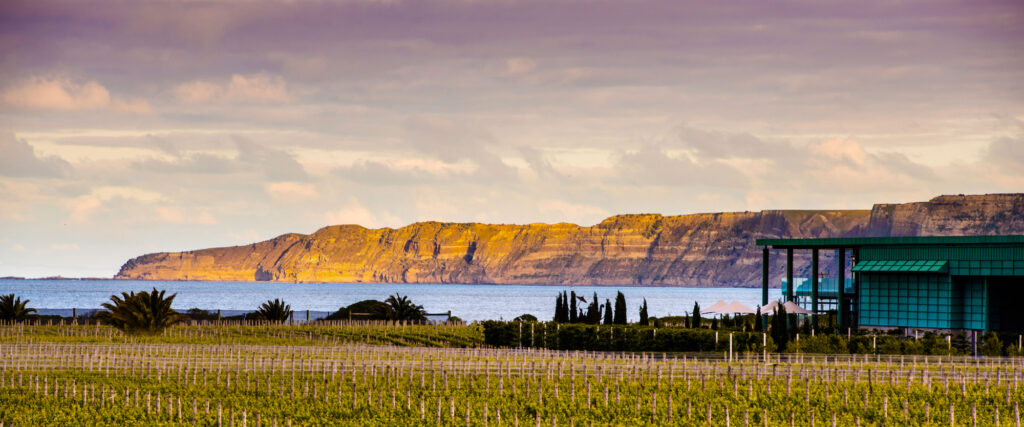
The site here is stony for the first two hundred metres into the property, and then it becomes a mix of sandstones and silt, and then as you back it becomes clay and there’s a heavy pan a few metres down. The Chardonnay and Syrah are all on clay.
The 2017 Reserve shows from one of the most tricky years in Hawke’s Bay, since Pinatubo erupted in ’91 – the coolest vintage in Hawke’s Bay history. A season of two halves, and it didn’t affect the Chardonnay so much, with it being the first variety to come into the winery. And only the best fruit makes it into the fermenters anyway. This Reserve spent six months on lees in tank to build weight, and also for the first time got some fruit – just 3-5% – from the Bridge Pa site – the clone called the ‘Muscat clone’ and I think you can see that coming through – almost a Turkish Delight flavour. The top Burgundy houses put that amount into their wines – you wouldn’t want to overdo it.
We normally keep well away from Malolactic Fermentation, but there’s about 10% in the 2017, being such a cool vintage – to build a little texture in the wine.
WF: is that right? Because consumers start to pick up on the terminology – malo, wild ferment, lees, handpick.. and they start to associate that with “better quality” or “better winemaking”? They learn these words and try and use them and look for them on labels.
Steve: All of our Chardonnay is barrel fermented, and it would go through Malo – if I inoculated for it, but also because I don’t want it, I keep the Chardonnay room quite chilled. Chardonnay being a white has a naturally low pH and at 10-12 degrees celcius nothing’s going to happen.
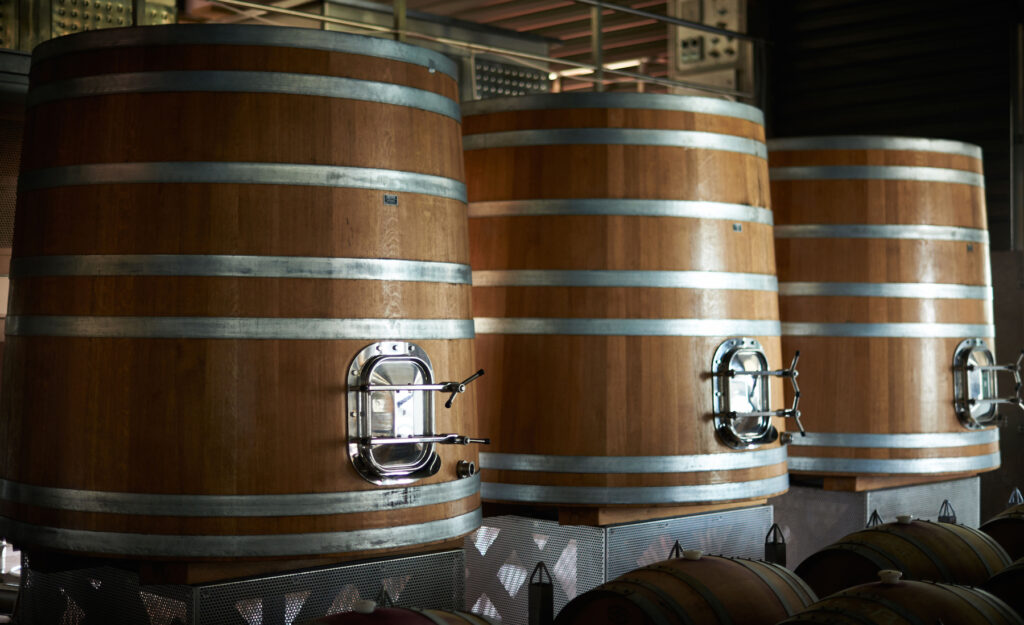
WF: You’re not looking for the reductiveness?
Steve: I’m not a big fan of that heavy reduction in Chardonnay. I don’t mind seeing a bit of flintiness coming through and savoury notes – I think it helps bring the wine together and accentuate fruit. You might see that a bit more in the top tiers but it will never be in-your-face, full-on reduction. I think it steals too much from the quality of the fruit. The work you’ve done in the vineyard to actually showcase the fruit, and then the winemaker puts a stamp of reduction on it?
WF: I think the mark of a good wine, is the last glass out of the bottle – not the first.. so you get one of those really heavily reductive chardonnays – and can you drink a whole bottle of that?
Steve: You have one glass and move on. And some of them don’t age particularly well. You can alter the turbidity of the juice going to barrel and play around with that kind of thing, and timings of certain sulphur additions. But we don’t actually sulphur our chardonnays until about now, so they spend the best part of eight months unsulphured in barrel. In a cool room, topped, and stirred regularly. Lees is all the antoxidant we need until the summer and it gets too warm. And we get a lot better integration of oak with wine if you don’t sulphur. If you use sulphur in wine you retard it’s evolution – slow it right down, so we try and keep the wines as unsulphured for as long as possible. It also means you get bone dry. These wines have got zero grams per litre of residual sugar. These wines have had ten months to ferment through to this, and I think you get better wines for that.
WF: There seems to be this perception, internationally, that New Zealand whites are sweet – because of the fruit-forward flavours.
Steve: As you go up the tiers, and this is probably true for most wineries, you are cropping low. Getting more extract, even in whites – dry matter and extract count, and that always comes across on the palate as weight, texture and, to some people, “that must mean sugar”. Sugar and ethanol give volume. Because of our cropping levels I think we get quite full bodied characters coming through. The further up the range you go, the more longevity the wines will have.
‘Dry extract’ – you would normally talk about it with red wines, because with reds you’re fermenting with all the skins and seeds, but you can measure extract of any wine. So if you take a litre of wine and you boil it down – carefully – and then you weigh the sediment, the ash left at the end of it – that’s dry extract, and it’s measured in grams per litre. Theoretically, the better a wine, the higher dry extract it has. It’s things in the wine that appear on your palate – tannins, phenolics.. And in wine, there’s a range of sugars that aren’t reducing sugars, so when we say a wine is dry we mean no glucose or fructose left in them, but there’s a whole lot of long-chain sugars that don’t have any sweetness factor, but have a texture factor.
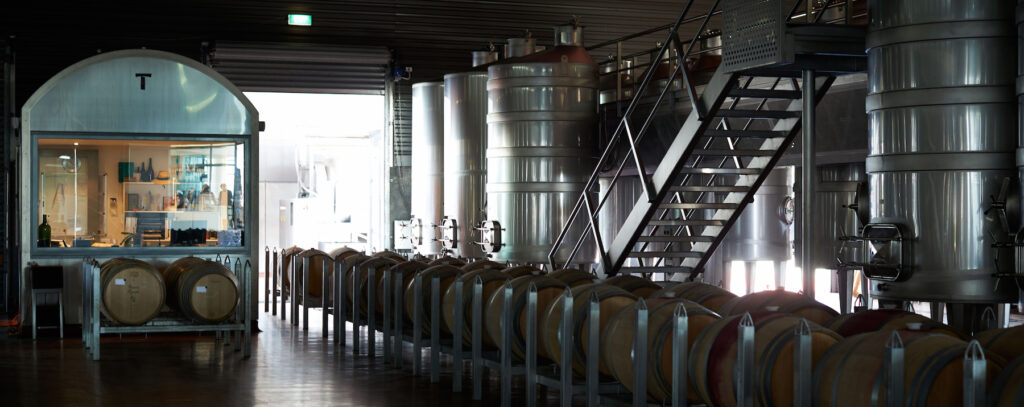
The last of the Chardonnays is the ‘Salome’ so that’s our top tier. It’s the opposite philosophy I guess of the ‘Sea’. This is always going to be a blend of the vineyards – basically the best fruit from the two vineyards that produce Chardonnay.
WF: Who says what the best fruit is? Whose responsibility is that?
Steve: After 14 years we’ve identified what that is. We’ll have pruned these vines quite differently, and we’ll leave pluck them at different times, and cropped at different levels. So they get a completely different level of management to the Reserve or Estate. We do over 120 picks across 250 tonnes every year. Our average ferment size is two and a bit tonne. Where we were aiming for a degree of purity with the ‘Sea’ – to showcase that vineyard… the ‘Salome’ probably gets a bit more winemaking intervention. You’ll see a bit of reduction coming through. More power of oak, and a bit more weight and texture being built into the wine. And because the fruit is so concentrated it can stand a little bit more, without, hopefully, it not being too heavy handed. There’s no more oak as a percentage than in the ‘Sea’ but we’ll go for a heavier toast. The crème brulee taste in a white wine can come from having the oak charred quite heavily.
Simon: Stylistically they wines are different expressions, but there’s a common ‘fineness’ to them all
Steve: This is where the vineyard combinations start mattering, because you’ve got Bridge Pa which is a warmer zone than Te Awanga. So even with the same clones you’re getting different ripeness and different levels of flavour that come from that ripeness. You get 2kg of fruit per vine at this level, it’s just the difference in the vineyards that flows through to the wines.
WF: I can see why they’re designated the way they are – it fits.
Simon: The last two wines are at the same price point for both wines, so it’s interesting to see who likes what, because there isn’t a right answer. They’re two very different expressions.
WF: Can I just take a look at the labels? Because although at first glance they look similar, and very classy, they are different for each tier aren’t they? With the blue-green, then the silver and the gold. And the blue-green is like the colour of the building. I’m staying up at Millar Road, and can see the building from the terrace there. Gregory was telling me that when the rivers are in full flow, the water in the bay is the same colour as your building “It’s so clever – so beautiful” he said.
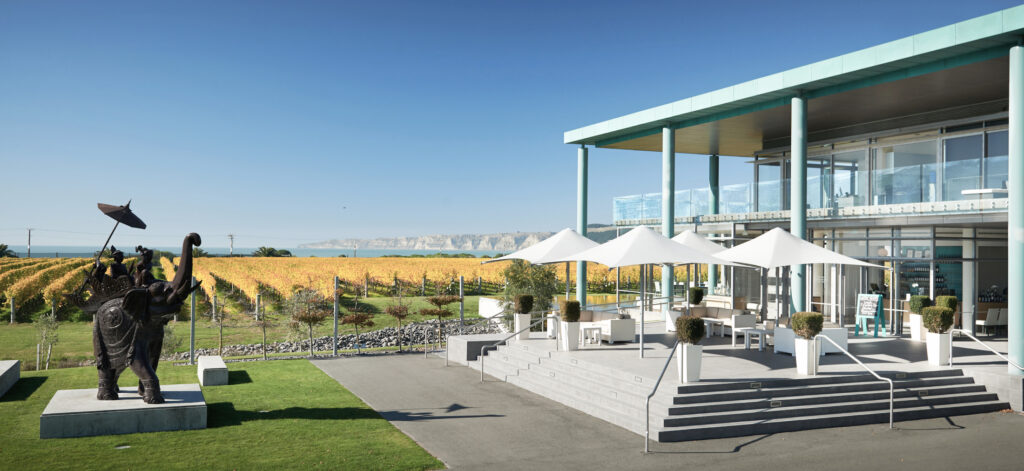
Steve: And it’s reverse ageing. When it first went up, a couple of the locals were quite anti it, because it was solid green, there was no defining copper to it. But if you look around, the vineyard building, which is the oldest building where it’s weathering – you can now see large swathes of the copper coming through where the green is coming off. So now it’s reverse ageing back to what it’s supposed to look like.
WF: speaking of age – how do these chardonnays go? What’s the best, oldest one so far? And are they always under screwcap
Steve: Well, we’ve only been making the ‘Salome’ since 2016, but I feel easily 5-10 years. The whites have always been under screwcap. The reds, some of them started as cork, and then we’ve started to do half cork, half screwcap depending on the market demands. I prefer screwcap if I can get away with it.
Simon: So these are a single vineyard story, without using those words because you see that everywhere, and what does that mean? A single vineyard can be a 1000 hectare.
Steve: A single vineyard means to me that you are letting the vineyard do the speaking. These get different oak, different temperature ferments, different amounts of whole cluster if they are Syrah. So we are tailoring the winemaking to what we think the strengths of the vineyard are. So, they are single vineyard, but they’re interpreted differently in the winery. When you come and look at the average amount of whole cluster in one wine compared to another – there’s four times as much whole cluster in that because I wouldn’t dare to it to the Gimblett because it would get too tannin and stalky. But I need to do it to that… to tailor down the richness of the fruit. If I was just being a single vineyard winemaker I’d do the same thing with the same yeast – because the defining thing is the vineyard. When this whole idea came out in 2015 it was very much ‘this is not a single vineyard story’ – it is a ‘single sub-region story’. As long as that’s the message that gets to people.
Simon: Earth, Sea and Stone are easier to remember from a simplistic perspective than Crownthorpe, Bridge Pa, Te Awanga, Mangatahi. We want to be able to translate the sub-regionality in an authentic but easily recognisable way. In 2023 we will launch a “Sea Syrah”, so a 2020 vintage Syrah from this sub-region.
Steve: And they’re not required to be made every year. They’re made in years where they represent the vineyard, and the idea of what we’re trying to do with the wine. So in ’19 there’s a ‘Stone Syrah’ but there’s probably not an ‘Earth Syrah’, and in ’20 there will probably be all three. There’s no compulsion to make them.
Simon: As a Sales and Marketing person, my job is to translate the work we do in the vineyard and winery into the marketplace. And the easiest thing to say is “this is from this vineyard, in this region, with these soils and this clone etc”. But sometimes that’s a foreign language to a lot of audiences. Not being patronising to the audience, and I think this is a really smart way of telling that story.
Steve: If you came through the winery 6 months after harvest, we might have done 35 different picks across the Syrah. With 3 vineyards across all of the clones, across whole cluster, and viognier and co-fermented – and so you have 35 different batches in barrel.
This Reserve Syrah is a 2017 – looking at the worst vintage in 30 years! Really, it was a very tricky vintage. We estimated going into it that we would get just on 300 tonne of fruit. We picked 180 and I’d estimate we sorted another 30-40 tonne out. So we produced less than half, but doing that enabled us to make our top wines. Less volumes and obviously a style that reflects a cooler, challenging year. But they were still good enough – to make them. We put in a lot of work. We had people sorting in the vineyard, then an optical sorter, then a sorting table. Every step of the way taking out what wasn’t going to help the wine.
WF: is that a reflection of the year – or do you not need to go to that much trouble in normal years?
Steve: We always use the optical sorter for Bordeaux varieties. We don’t tend to do it with Syrah as much because we do a lot of whole cluster with Syrah. And then in that really cool year we pulled that whole cluster component right back. You get a lot more red fruit in this vintage – that’s the vintage talking. We pull back on the temperatures of the ferments; we pull back on the amounts of whole cluster we used, and the amount of new oak we were using. It depends, in good years when you get to this level, you can put 50% new oak into a blend and you don’t even see it. Our 2015 Airavata was about 75% new oak but you wouldn’t know it. It’s looking at the fruit coming in and saying how do you make it, so you don’t push it where it doesn’t want to go. There’s a corridor where the wine is happy to go, and if you push it, or turn off that corridor, the wines become clumsy.
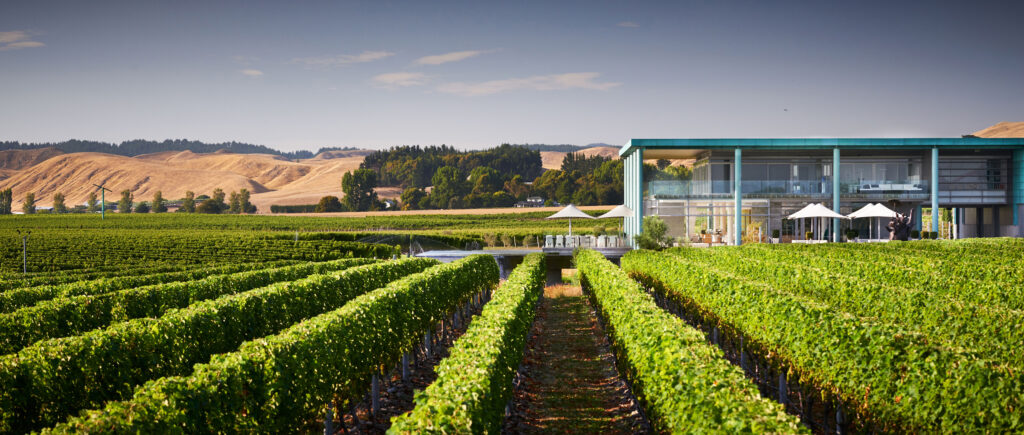
WF: I do find though with Hawke’s Bay that often the good wines from a cool year are better than the good wines from a warm year?
Steve: well, you work a lot harder and think a bit harder. In a good year the challenge is how to elevate really good fruit, because you already know that’s good fruit, so it’s going to make great wine. What’s the stretch to take it to the next level? When it’s raining outside for the third week in a row, you’re thinking how am I even going to make a Syrah?
WF: How does that make you feel – let’s say there are three bad years out of the last ten – that’s 30% of your ability to make outstanding wine, either taken away, or at least, toyed with?
Steve: You learn how to make great wine in those bad years. Hopefully you learn a couple of things and think to yourself “wow, if I do that with great fruit…” Nothing against Napa or California… but when I first turned up for a harvest there – there was a big whiteboard up on the wall. And they had all the picking dates for the coming year. It was too easy. So, in three weeks and two days time, we’re picking our top Cabernet. Not because it’s tasting fantastic, but they just knew it would be ripe. They might be out by a day, but pretty much they’d scheduled it. We can’t do that here, can’t even dream about doing that.
WF: it must be hard though to know – let’s say, a top golfer – has hundreds of holes of golf to play the best round, or shoot a hole in one and really nail it, just in one year – you’ve only got 30 or 40 vintages in you.
Steve: That’s why you do over 100 picks in a year. Since we’re one of the youngest Hawke’s Bay wineries, that was one way of catching up – with the knowledge of our vineyards. Make more wines per vintage – don’t wait for the vintages to just roll around.
A 2015 Bridge Pa ‘Earth’ Syrah – this had 35-40% whole cluster, and the thing is with the ripeness of Bridge Pa – if you don’t add that in, you end up making little Shiraz lookalikes. Because they do have a lot of natural sweetness in the fruit. The wine is bone dry, but the fruit sweetness comes through. And if you didn’t pull it back with the texture you get…
WF: So you could make a Syrah as good as the Aussies – is that what you’re saying?!?
Steve: Almost.
WF: it’s funny though – because if you speak to an Australian – they are absolutely making the best expression of Syrah or Shiraz that they can make. And they think that’s the best expression of Syrah in the world – they’re making the best version of it, anywhere – the pinnacle. And we do something else, and we think that’s the epitome of what you can do with Syrah!
Steve: ‘Airavata’. 2017 again. This is actually all Gimblett fruit. It was by far the strongest vineyard that year. A bit less crop – we went in thinking we would be cropping at 1.5kg per vine, so we got plenty of concentration in the grape. It was just a matter of nursing them through the wet weather, and Gimblett does that a lot better than most sub-regions in Hawke’s bay. The water is drained away before the vine can suck too much up. If you get solid days of rain at Bridge Pa or here, with saturated soils, the vine sucks up so much water that the thin skins of Syrah can split. Start getting splitting then you’ve got botrytis issues, so you’re really obliged to start picking.
For me, it’s important that, if you can, you should make wine in these tricky vintages. Hawke’s Bay can’t be a great Syrah region if it only makes it in great to good years. The wine might be a bit lighter, or simpler, or whatever, but it should still have texture, concentration and all the things that make good wine. I think Hawke’s Bay can do it with Cabernet dominant wines too. The best fruit we got in in 2017 was Cabernet Sauvignon.

